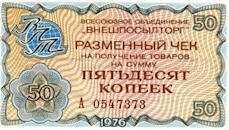Валюта и берёзки
Русский > Контекст > Экономический контекст > Валюта и берёзки
Foreign currency
In chapter 9 of The Master and Margarita, Nikanor Ivanovich Bosoy, the chairman of the tenants’ association of Bolshaya Sadovaya 302-bis, gets arrested because the bribe that he had accepted earlier from Koroviev appeared to be foreign currency. In the '30s, the Soviet roubles and chervontsi were no longer convertible currencies, so government was constantly in need of foreign valuta to trade. The exchange rates for foreigners visiting the Soviet Union were extremely high.
Soviet citizens were not allowed to have foreign currency. Buying or selling foreign currency on a black market was a serious crime until the late eighties. The regime organised campaigns to confiscate foreign currency, gold and jewels of the population in 1928-1929 and in 1931-1933. Those campaigns were set up by the notorious secret police, the Объединённое государственное политическое управление (ОГПУ) [Obedinyonnoe gosudarstvennoe politicheskoye upravlenye] (OGPU) or the United State Political Administration.
The suspected валючыки [valjuchiki] or foreign currency speculators were put in jail for several weeks until they «voluntarily» gave up their foreign currency and their valuables. The confiscated items - jewelry, icons, Faberge eggs, porcelain and rare manuscripts - were sold abroad, mainly in the United States. The regime needed hard currency to import goods to ensure the success of the Five Year Plans. The American historian Robert Chadwell Williams (1917-1991) summed it up as: «Tractors were needed more than Titians, Fords more than Fabergé». A wide variety of methods were used to get the population handing in their goods, such as giving salted foods and abstain people from drinking water. More sinister methods are described in the book I Speak for the Silent (1935) by the Russian professor Vladimir Vyacheslavovich Chernavin (1887-1949), a contemporary of Bulgakov.
Click here to download the full text of I Speak for the Silent [en]
Beryozka
In the '30s, the regime also tried to get foreign currency through the Torgsin stores, in which anyone with hard currency and valuables could purchase goods such as food and clothing which were unobtainable for Soviet citizens in normal shops. Later, in 1964, the берёзка [beryozka] or foreign-currency-only shop was introduced.
Normal shops in the Soviet Union had a huge problem of goods supply and the goods presented were strongly uniform. And it was quite common to queue for a long time to buy the most basic things.
The beryozkas or currency stores, however, overflew with a wide variety of quality products, often from abroad, that had to be paid with dollars or special coupons. An example of such store was the Государственный универсальный магазин [Gosudarstvenny universalny magasin] or State universal store, now called Главный универсальный магазин [Glavny universalny magasin] or Main Universal Store on the Red Square in Moscow. Both the old and the contemporary names are abbreviated ГУМ [GUM].
The beryozkas were operated by government and exclusively meant for foreigners and their families, but Communist Party officials, high-ranking bureaucrats and other privileged Russians having foreign currency or special coupons could enter too. Writers like Bulgakov, who sometimes received foreign currency for the publication of their work abroad, were even bound under an obligation to spend their currency in the Torgsin and beryozka stores. Bulgakov regularly went to the currency shop Torgsin on the corner of Arbat and Smolenskaya, where, in chapter 28, Behemot smashed everything in sight to pieces and even burnt the place down.
The currency problem has not yet really disappeared in today's Russia. It is no longer like it was under Stalin, but foreign currency is still subject to discussions. When, in the eighties, a free conversion of currency was allowed, the exchange rate plummeted from its official values by almost a factor of 10. That's why Russians often express the value of durable goods, houses or trips abroad in US dollars, although everything is to be paid in roubles. The use of the dollar to express the value of things is a thorn in the flesh of the Putin administration. In May 2006 a bill was put forward in the Duma, the Russian parliament, to forbid such practices. Yet, I still know many Russians who get their salaries - or part of it - paid in US dollars or in euros
Beryozkas in the 21st Century
The scene from chapter 27 of The Master and Margarita, entitled The Last Adventures of Koroviev and Behemoth, in which Woland's two gang members set the Moscow department store Torgsin in turmoil, became hotly topical again in the summer of 2022.
Many well-known brand names were harder to find in Russia due to Western sanctions following the Russian invasion of Ukraine. Shoppers flocked to H&M's stores in early August 2022 as the Swedish clothing retailer briefly reopened its doors for a final inventory sale before leaving the country for good.
And so Russia revived the Soviet-era practice of duty-free shops for foreign diplomats, allowing them to buy goods that are no longer imported into Russia. The government's order to do so was issued in late July 2022. The stores could open in Moscow and St. Petersburg shortly after the law goes into effect on August 27, and they will accept payments in dollars and euros.
Sergey Smirnov, the editor-in-chief of the Russian media magazine Mediazona said: «All the way back to the USSR!» And he is right, because with this practice we are once again in the policy of the beryozka shops for the bureaucratic elite, which Bulgakov denounced in chapter 27 of The Master and Margarita.
Поместить эту страницу |


